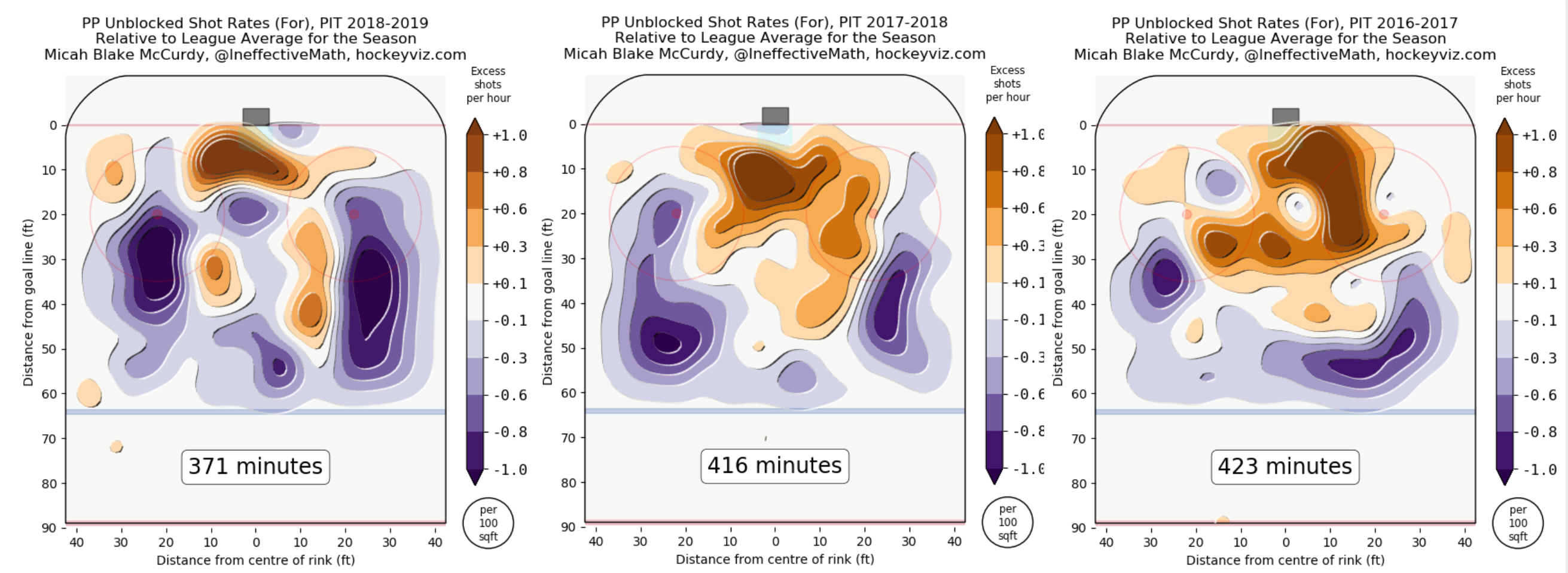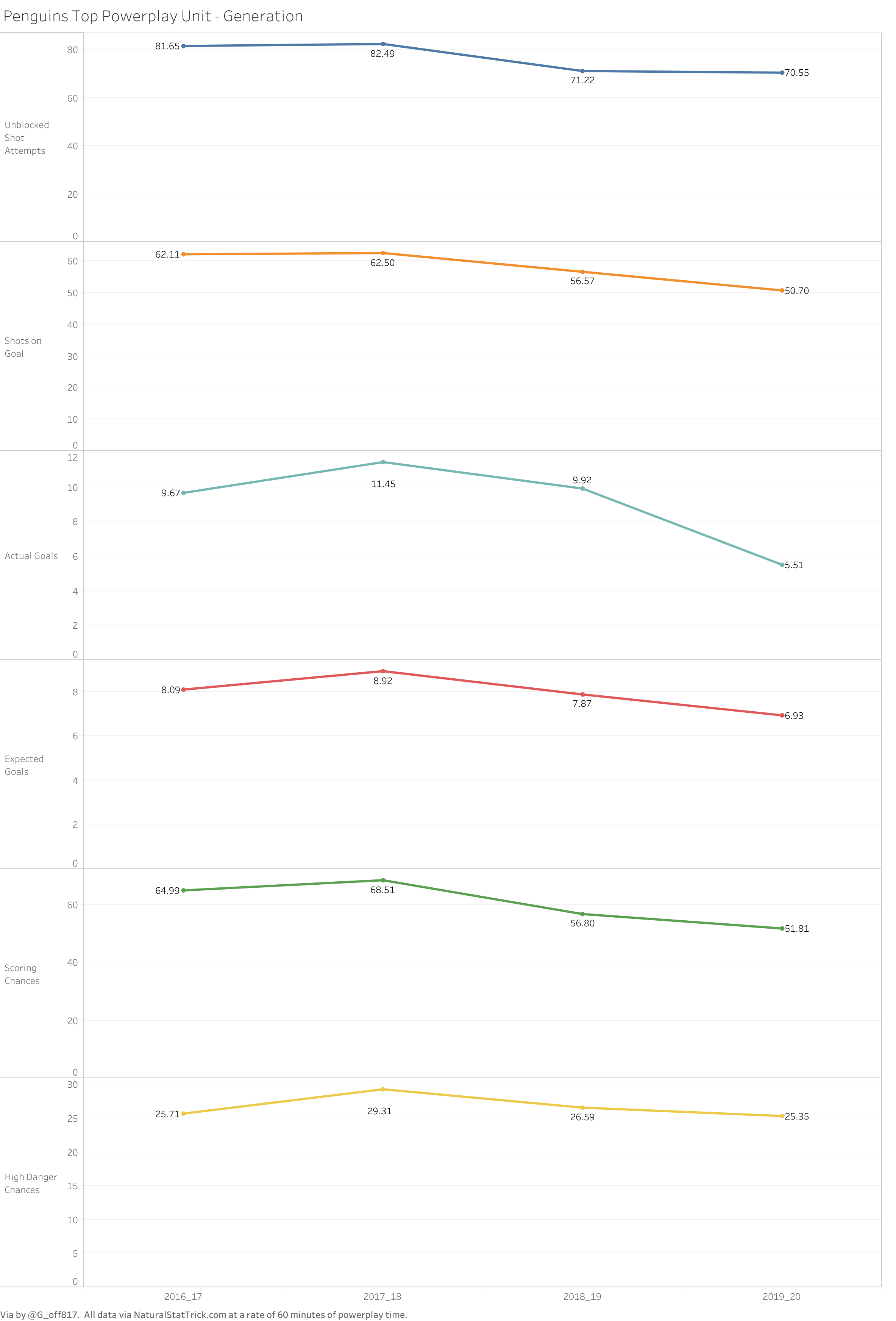The Penguins powerplay sucks.
But just don’t take my word for it:
Evgeni Malkin:
"The power play, it sucks."
— Seth Rorabaugh (@SethRorabaugh) November 8, 2019
Rightly or wrongly, a powerplay is judged based upon the frequency with which it puts the puck in the net. And for the Penguins, they’ve managed to do that on just six (6) times this season on 45 opportunities, a success rate of a paltry 13.3%.
That percentage ranks them 25th in the league.
For a team that ranked 5th (24.6%), 1st (26.2%), and 3rd (23.1%) in each of the last 3 seasons, seeing them at the bottom of the league on the powerplay is uncharacteristic.
Some of this can be attributed to Evgeni Malkin having only played 5 games this season, but since his return on November 2nd against the Oilers, the Penguins have had 8 powerplay opportunities and found the back of the net exactly 0 times.
In fact, the last time the Penguins scored a goal on the powerplay was nearly a month ago, coming on October 13th in Winnipeg.
This drought has stretched 10 games, 22 opportunities, and 41:30 without a goal. Systematically, they haven’t seemed to click this season in terms of getting shots from high percentage areas of the ice:

What you see here is telling. While there is a small portion of brown that extends into the crease, signifying that the Penguins get more unblocked shot attempts from that area than the league average, they are simply underperforming almost everywhere else that usually nets you goals.
That shows up everywhere in the middle of the ice, where you see that enormous strip of purple. Translation: compared to the league average, the Penguins are not getting shots from the low slot all the way up to the center point.
This is bad.
In the context of the previous three seasons, it’s extremely telling as to maybe why the Penguins are netting as many powerplay goals this season:

All of that brown directly in front of the net tells you almost everything you need to know. In each of the last three seasons, when the Penguins powerplay was so dynamic and deadly that it was near impossible to stop, they were generating far more unblocked shot attempts from the front of the cage than that of the rest of the league.
Now, it should be noted that, via NaturalStatTrick’s Expected Goals model, the Penguins 7.02 expected goals per hour of powerplay time ranks 9th league-wide, while they are also generating the 7th most scoring chances (55.21) and 7th most high danger chances (22.87) per 60 minutes of PP time. They’ve converted 20% of their high danger chances into goals, the 14th best percentage in the league.
| Season | Unblocked Shot Attempts | Expected Goals | Actual Goals | Scoring Chances | High Danger Scoring Chances |
| 19-20 | 73.36 (13th) | 7.02 (9th) | 4.73 (26th) | 55.21 (7th) | 22.87 (7th) |
| 18-19 | 65.6 (27th) | 6.71 (14th) | 8.87 (5th) | 49.44 (12th) | 22.34 (9th) |
| 17-18 | 75.57 (22nd) | 7.76 (7th) | 9.77 (1st) | 59.19 (4th) | 25.72 (7th) |
| 16-17 | 76.15 (14th) | 7.36 (7th) | 8.46 (4th) | 58.67 (3rd) | 23.69 (6th) |
Note: all data here via NaturalStatTrick.com and is at a rate of 60 minutes of powerplay time with league rank in parenthesis.
From a raw numbers perspective, this season has tracked far more closely to last season than either 2016-17 or 2017-18. The main differences being that the Penguins have generated nearly 8 more unblocked shot attempts per hour of play than last season and nearly 6 more scoring chances, but a similar amount of high danger chances and expected goals.
The end result was there last year.
It hasn’t been this year.
But when you consider where those unblocked attempts are coming in from relative to the rest of the league, it’s hard not to imagine there being a system-specific difference this season compared to previous seasons.
But to answer that question, we must first ask ourselves this: What has changed for the Penguins powerplay from each of the last 3 seasons to this season?
The answer, of course, is Phil Kessel.
In trading Phil Kessel, the Penguins traded away one of the most prolific powerplay specialists this league has seen. In fact, from 2015-16 until last the end of the 2018-19 season, only one player in the NHL scored more powerplay points than Phil Kessel’s 125: Nikita Kucherov (141).
Coming in 5th and 6th on that list are Sidney Crosby (116) and Evgeni Malkin (114).
There is also a significant case to be made that the Penguins powerplay over that 4 year period of Kessel’s employment that the PP ran strictly through Phil Kessel rather than that of a traditional powerplay quarterback like Kris Letang or Justin Schultz and, in 2018, was tops in the league at putting passes into the slot.
Even if you don’t buy into that, at a minimum, it gave the Penguins elite threats on both sides of the net and a player prolific at gaining entry into the zone on the man-advantage.
https://gfycat.com/coldappropriatehellbender
https://gfycat.com/plumpfabulousdog
https://gfycat.com/pitifulopenindianjackal
With that, let’s examine the Penguins’ top powerplay unit in each of the last 4 seasons in the context of with Sidney Crosby on the ice this season and with Phil Kessel on the ice over the last 3 to see if maybe there’s something hidden there.
The reason for this is two-fold:
- it’s easier to manage (and isolates Kessel’s impact a bit), particularly when considering that Phil Kessel did not miss a single game as a Penguin and
- it works under the assumption that both players exclusively played PP1 minutes, which we know to be true. From 2016-2019, Kessel and Crosby played 773:18 of PP time together, while Kessel saw just 93:46 without Crosby and Crosby played 51:06 without Kessel. So to assume that the following accurately represents the results of the top powerplay unit is probably true.
What you see here is that, since the removal of Phil Kessel from the Penguins, the powerplay unit that has deployed Sidney Crosby this season is performing at a 4 season low across all 6 data points compared to that of the unit that deployed Phil Kessel in each of the previous three seasons.
There are some things to consider here as well. Notably, the injuries the Penguins have had to deal with early this season. Though, PP1 staples like Crosby, Malkin, Hornqvist, Letang, and Schultz have all missed time at various points over the last 3+ seasons, they’ve still usually had Kessel and Crosby to rely upon when on the powerplay.
This season has been different as Malkin and Galchenyuk (Kessel’s replacement) missed time early on and now Letang and Hornqvist are out as well, leaving the Penguins to rely solely on Crosby and Guentzel to get the job done to a large degree this year. Guentzel is a great player in his own way, but he’s not the powerplay specialist that can run and operate on the opposite side of the ice from Crosby (or Malkin).
Now, 72 minutes of PP isn’t a large sample size and the same can be said about the nearly 55 minutes of PP time Crosby has played himself, but some of what’s been seen through those 72 (or 55) minutes is at least alarming. The previous 3 seasons yielded an average of 403.33 minutes of PP time and the 72 minutes the Penguins have already played could likely account for about 17.85% of their overall powerplay time on the season, leaving them with abut 82% of the season’s PP time to right the ship.
And so far, based upon the limited sample size we’ve seen thus far, they haven’t done nearly enough to bridge the historical gap left by the departure of Phil Kessel.
But as we’ve seen through the years, all it takes it one game for these guys to get off the schneid and go on an absolute tear.
Hopefully that comes sooner rather than later.
Header image credit: Associated Press
Add The Sports Daily to your Google News Feed!

